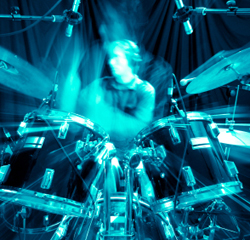
Snare Top
Getting perfect phase between the snare top and rest of the mics so far is impossible. The placement is so close that it’s functioning on a different time map. So we don’t really need to worry much about phase here, exactly.
A better way to approach it is finding the mic placement with the overheads on and listening to where the snare seems to “lock in” with them.
Once you find that placement the real key to getting a great snare sound is eliminating the hi-hat bleed. You can really bend and shape a snare sound if it’s isolated.
Two useful techniques for cutting down on the hi-hat bleed are facing the rejection spots of the snare mic toward the hat, and placing auralex foam behind the mic capsule. Cut a small slit in a 6″x6″ square of auralex and saddle it over the handle of the mic. Crude but effective.
Snare Bottom
A very common mistake is to put the snare bottom mic very close to the bottom head of the snare. Almost as if you were miking it the same way as the snare top. Remember, phase is all about equal distance.
What you really want to do is place the snare bottom mic the same distance from the bottom snare head as the top snare mic is. In other words, if you have a drum that’s 6″ deep, and the top snare mic is 1 inch above the top head, it’s 7 inches away from the bottom snare head. That means you want the bottom snare mic to be 7 inches away from the bottom head.
Room Mics
I haven’t found a perfectly mathematical approach that works for placing room mics. Assuming I don’t want an especially close or far away sound, I just try to find a sweet spot.
One way to do this is to invert the polarity on a mic and monitor playback from the overheads and inverted mic summed mono. Try to find a place in the room where all the good tones seem to get sucked out and you’re left with something that sounds harsh and thin. When you flip the polarity back to normal you should find that it sounds pretty darn good. This is where you want to set up the room micas.
Conclusion
Lastly, if you are using any other mics—an inside kick, batter’s head kick, hi hat mic, front-of-kit or center overhead mic, whatever, the same ideas apply. Find the key spots where you get successful phase interaction and your kit will sound cohesive and have a great tone.
A/V
Below is an audio sample of the tracked drums from my session this weekend—no EQ, no compression, just mic placement.
Matthew Weiss engineers from his private facility in Philadelphia, PA. A list of clients and credits are available at Weiss-Sound.com. To get a taste of The Maio Collection, the debut drum library from Matthew, check out The Maio Sampler Pack by entering your email here and pressing “Download.”
Also be sure to visit The Pro Audio Files for more great recording content. To comment or ask questions about this article, go here.
